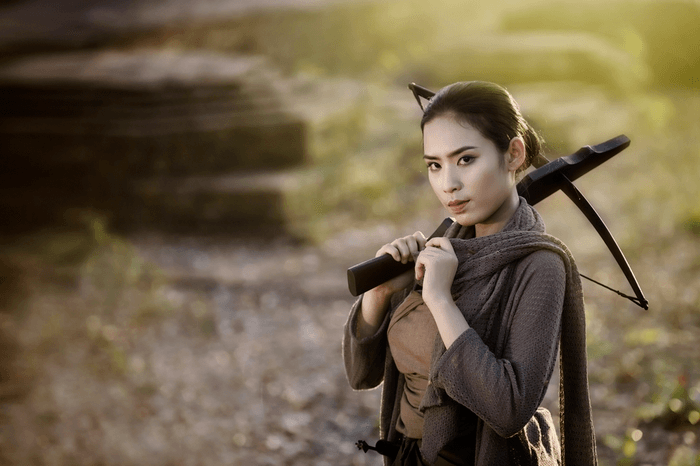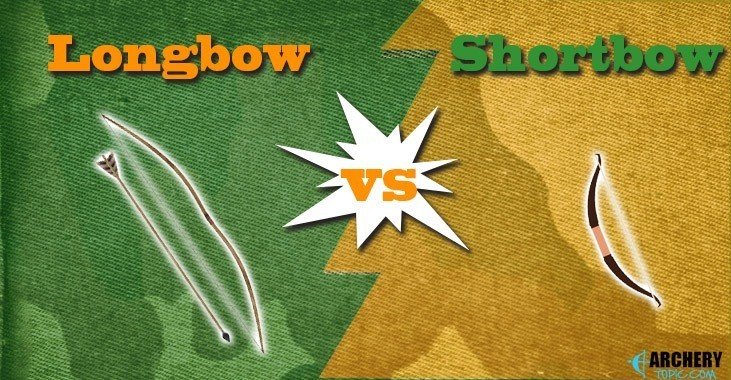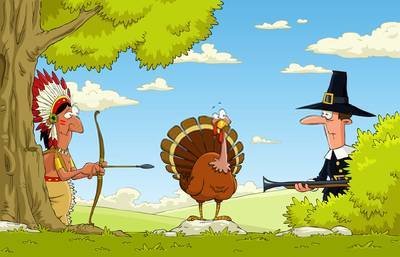Archery has been an essential part of warfare and hunting for centuries.
Two types of bows that have gained immense popularity throughout history are: the longbow vs shortbow.
While they may look similar, there are significant differences between these two weapons.
By the end of this article, you will have a clear understanding of the unique features and advantages of each bow, helping you choose the best one for your needs.
Longbow vs. Shortbow Brief Comparison:
Longbow and Shortbow are both types of traditional archery equipment that have been used for centuries.
While they have some similarities, there are also some distinct differences between the two.
Here are some advantages and disadvantages of longbows and shortbows:
Bow Types | Advantages | Disadvantages |
|---|---|---|
Longbow |
|
|
Shortbow |
|
|

What is a Longbow?

A longbow is a type of bow that is tall, roughly the same height as the user, and has relatively narrow limbs that are made of a single piece of wood.
It is commonly used for hunting in medieval Europe and has been used by many cultures throughout history.
The longbow requires a significant amount of strength and skill to use effectively, but in the hands of a skilled archer, it can be an accurate weapon.
Longbows have a “D” shape curve that allow more energy to be stored in the wooden part of the bow.
This curve is what contributes to the longbow’s overall performance.
A decent longbow is constructed from a single piece of wood, which increases its durability.
Pros:
The following are some benefits that make longbows a preferred option for archers and hunters:
1. High Durability:
Longbows are made from durable materials such as wood and fiberglass, making them long-lasting and able to withstand heavy use.
2. High Versatility:
Longbows are commonly used for shooting animals such as deer, elk, and other large mammals.
Hunting with a longbow is usually successful since you can easily shoot heavy arrows that won't get affected by the wind.
The high versatility of a longbow can be justified with the fact that it accommodates arrows of different weights and lengths.
3. Long Draw Length:
The draw length is the distance to which the arrow can be pulled towards the archer before being released.
Longbows have a longer draw length than other types of bows, which allows for greater power and range.
This makes them ideal for long-distance shooting, such as in hunting or target archery.
4. Stores More Energy:
The Longbow is a type of bow that stores energy through the bending of its limbs.
As the bowstring is drawn back, the limbs flex, storing potential energy.
When the bowstring is released, the limbs quickly snap back to their original position, transferring the stored energy to the arrow and propelling it forward with greater force and velocity.
This allows for more accurate and powerful shots than traditional bows.
More energy equals force and accuracy, therefore if you have an eye for detail, you will be able to hit your targets more effectively.
Cons:
- Longbows are typically louder than modern bows, which makes it more difficult to get close enough for a shot.
- Due to its large size, it can't be used in tight spaces.
- It's more difficult to learn compared to modern bows because it requires more skills and practice.
- It's not 100% reliable due to factors such as weather, human error, and limitations in target that may affect the arrow destination.
- Extremely hard to draw and needs a lot of stretching power.
What is a Shortbow?

A shortbow is a type of bow that is shorter in length compared to a longbow.
These bows are typically shorter than 5 feet with the majority of them falling under the 3 feet long range.
They are designed to be used in close range combat and are commonly used by archers for hunting and target shooting.
Shortbows are easier to handle than longbows, making them ideal for use on horseback or in confined spaces.
They have a simpler design, with a curved wooden stave and a string, and are often used in traditional archery competitions.
Some examples of short bow include airbows, mongol bows, etc.
Pros:
1. More Silent In Action:
The shortbow is more silent in action than other bows because it has a shorter draw length, which means less force and energy is required to release the arrow.
This results in less noise and vibration when the arrow is released.
Additionally, the shortbow is usually designed with a smaller profile and fewer components, which also contributes to its quietness.
2. Fires Arrows Faster:
Shortbows have a shorter draw length, which means that they can be fired more quickly than longbows.
Even though the wood can't hold as much energy, you'II still be able to release more quickly because it won't take as much force to pull the string back.
3. Great For Tight Space:
Shortbows are smaller and lighter than longbows or other types of bows, making them more maneuverable in tight spaces.
This makes them ideal for use in forested areas or for hunting small game.
You will be able to utilize the shortbow in restricted spaces without difficulty because less space is needed for your elbows.
4. Lightweight:
Shortbows are generally simpler and easier to use for archers participating in horseback archery shooting than longbows or other types of bows.
They require less strength to pull back the string, and their lightweight makes them easier to handle and shoot.
5. Affordable:
Due to the simple and light design, short bows are typically less expensive than longbows or other types of bows, making them a more affordable option for archers on a budget.
6. Better Accuracy And Velocity:
Shortbows are more accurate and faster than longbows because they are shorter and more compact, allowing for easier handling and maneuvering.
Additionally, shortbows are generally lighter and easier to hold steady, increasing accuracy.
Cons:
They tend to have a shorter draw length and lower power, making them less effective at targeting longer distances.
Short bows can be more difficult to shoot accurately due to their shorter length and lower stability.
They require the archer to be closer to the target, which can be dangerous in certain situations.
Differences Between Longbow And Shortbow:

1. Length:
As their names suggest, the longbow is considerably longer than the shortbow, typically measuring between 5 and 6 feet in length, while the shortbow is between 4 and 5 feet.
2. Draw Weight:
Longbows tend to have a draw weight of 40 to 80 pounds, while that of the Shortbow ranges from 25 to 50 pounds.
This means that the longbow requires more force to draw its string back.
This makes them better suited for larger games, while short bows are better for small games.
3. Accuracy:
Because of their longer length, longbows tend to be more accurate than shortbows, especially at longer distances.
4. Speed:
Shortbows shoot arrows faster than longbows due to their shorter length, which allows for a quicker release of energy.
This makes the shortbow useful for hunting smaller, faster-moving game.
5. Weight:
The weight of a longbow ranges from 2 to 4 pounds, while that of a shortbow ranges from 1 to 2 pounds.
This shows that shortbows are generally lighter than longbows and it makes them easier to carry over long distances.
6. Maneuverability:
Because of their shorter length, shortbows are more maneuverable than longbows, making them better suited for hunting in wooded areas or other tight spaces.
7. Noise:
Longbows tend to be quieter than shortbows, which can be an advantage when hunting game that is easily spooked.
8. Range:
Longbows have a longer effective range than shortbows, which means that they can be used to hunt game at greater distances.
9. Traditional Use:
Longbows have a longer historical and cultural tradition in hunting, and are often used in traditional archery competitions and reenactments.
10. Skill level:
Longbows require more skill to use effectively than shortbows, as they are more difficult to aim and require more strength to draw.
Shortbows are generally easier for beginners to use.
Which One Is Better For Hunting Large Animals?

Longbows are particularly effective for hunting large animals such as deer, elk, and moose.
They have a long draw length and a heavy draw weight, which allows them to shoot arrows at high speeds and with great force.
This makes them ideal for taking down large animals quickly and efficiently.
Which One Is Better For Hunting Small Animals?

Shortbows are generally best for hunting small animals such as turkey, rabbits, squirrels, and birds.
Their compact size and light weight make them ideal for maneuvering through tight spaces in order to stalk prey.
Shortbows also tend to be quieter than longer bows, making them less likely to scare off game.
Ultimately, the best bow for hunting depends on the type of game you are pursuing, as well as your personal preferences and shooting style.
Final Thoughts:
Both the longbow and the shortbow have their own advantages and disadvantages.
The longbow is powerful and accurate, making it an excellent weapon for long-range combat.
On the other hand, the shortbow is lighter and more maneuverable, making it a great choice for close-range combat and hunting.
Ultimately, the choice between a longbow vs shortbow will depend on the user's specific needs and preferences.
Regardless of which bow you choose, it's important to remember that both weapons require skill and practice to use effectively.
With proper training and practice, both the longbow and the shortbow can be deadly weapons in the hands of a skilled archer.

I love this guide. It's well detailed and made me understood more on Longbow Vs Recurve
This post was extremely informative. I now know the pros and cons of both weapons and that longbows can shoot further as I've always suspected.